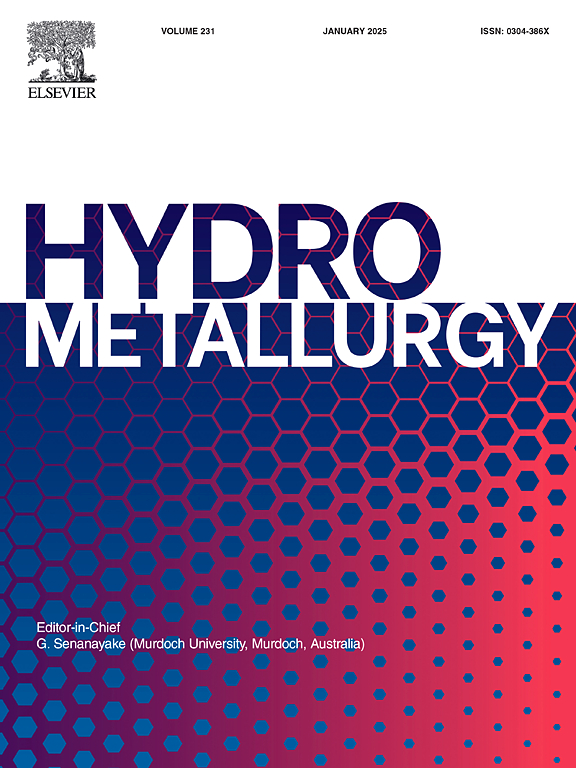Integrating lithium recovery with the production of high-purity lithium carbonate from spent lithium-ion battery smelting slag
IF 4.8
2区 材料科学
Q1 METALLURGY & METALLURGICAL ENGINEERING
引用次数: 0
Abstract
The pyrometallurgical extraction of valuable metals including nickel, cobalt, and copper from spent lithium-ion batteries (LIBs) has been applied in the industrial recycling of spent LIBs for many years. In conventional pyrometallurgical methods, lithium (Li) is concentrated in smelting slag, which is often discarded as waste without recycling. Given the global scarcity of Li resources, the extraction of Li from slag has become increasingly crucial. This paper describes the development of a green integrated process to efficiently leach Li from slag and separate it from other impurity metals, particularly aluminum in the resultant leachate, for the production of high-purity lithium carbonate. A leaching efficiency of Li could reach 97.8 %, under the following conditions: slag‑sulfuric acid ratio of 1:1 (g/mL), a temperature of 90 °C, a liquid-solid ratio of 5:1 (mL/g), a stirring rate of 350 rpm, and a contact time of 2 h. The resulting leach residue was found to be marketable hemihydrate gypsum (CaSO4∙0.5H2O). The majority of aluminum could be removed through precipitation as potassium aluminum sulfate (KAl(SO4)2·12H2O) by the addition of potassium sulfate to the leachate. Subsequently, residual aluminum along with other metals including nickel, cobalt, and manganese were removed through a series of pH adjustments. Trace elements of calcium and magnesium were also eliminated by the addition of sodium carbonate to induce carbonate precipitation. Finally, high-purity lithium carbonate was obtained through the addition of sodium carbonate solution. This hydrometallurgical process promises a significant utility in the extraction of Li from challenging spent LIBs smelting slag, offering a sustainable solution to resource recovery.

将锂回收与废锂离子电池冶炼渣生产高纯碳酸锂相结合
从废锂离子电池中提取镍、钴、铜等有价金属已在废锂离子电池的工业回收中应用多年。在传统的火法冶金方法中,锂(Li)被集中在冶炼渣中,而冶炼渣往往作为废物丢弃而不能回收利用。鉴于全球锂资源的稀缺,从矿渣中提取锂变得越来越重要。本文介绍了一种绿色综合工艺的开发,该工艺可以有效地从渣中浸出锂,并将其与其他杂质金属,特别是所得浸出液中的铝分离,用于生产高纯碳酸锂。在渣硫酸比为1:1 (g/mL)、温度为90℃、液固比为5:1 (mL/g)、搅拌速度为350 rpm、接触时间为2 h的条件下,锂的浸出率可达97.8%,浸出渣为可销售的半水石膏(CaSO4∙0.5H2O)。在渗滤液中加入硫酸钾,大部分铝可以以硫酸铝钾(KAl(SO4)2·12H2O)的形式沉淀去除。随后,通过一系列的pH调整去除残留的铝以及其他金属,包括镍、钴和锰。通过添加碳酸钠诱导碳酸盐沉淀,消除了微量元素钙和镁。最后通过加入碳酸钠溶液,得到高纯碳酸锂。这种湿法冶金工艺有望在从废锂冶炼渣中提取锂方面发挥重要作用,为资源回收提供了可持续的解决方案。
本文章由计算机程序翻译,如有差异,请以英文原文为准。
求助全文
约1分钟内获得全文
求助全文
来源期刊

Hydrometallurgy
工程技术-冶金工程
CiteScore
9.50
自引率
6.40%
发文量
144
审稿时长
3.4 months
期刊介绍:
Hydrometallurgy aims to compile studies on novel processes, process design, chemistry, modelling, control, economics and interfaces between unit operations, and to provide a forum for discussions on case histories and operational difficulties.
Topics covered include: leaching of metal values by chemical reagents or bacterial action at ambient or elevated pressures and temperatures; separation of solids from leach liquors; removal of impurities and recovery of metal values by precipitation, ion exchange, solvent extraction, gaseous reduction, cementation, electro-winning and electro-refining; pre-treatment of ores by roasting or chemical treatments such as halogenation or reduction; recycling of reagents and treatment of effluents.
 求助内容:
求助内容: 应助结果提醒方式:
应助结果提醒方式:


